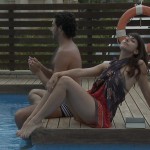¿Habéis visto mis gafas?
Paco has lost his glasses. While Paco looks for them, Sandro is playing with his Blackberry, while taking advantage of the situation…
In this episode you will learn: how to ask for something in Spanish, to ask for help in Spanish, to describe an object in Spanish.
PACO: Hola… ¿hay alguien ahí? ¿Habéis visto mis gafas? No sé dónde las he dejado. Y sin ellas voy totalmente perdido.
SANDRO: No,no,no,no qué va. ¿Has mirado por aquí, por el comedor?
PACO: Sí, he mirado por aquí, por allí… por todos lados y no hay forma de encontrarlas.
SANDRO: Aunque es un poco inútil que un miope busque sus gafas cuando sin gafas no ve nada, ¿no te parece?
PACO: Pues sí, tienes razón.
SANDRO: Bueno, vamos a ver si te puedo ayudar… Son negras ¿verdad? Negras como el mando de la tele.
PACO: Sí, sí
SANDRO:Bien. De forma rectangular…
PACO: Sí, sí…
SANDRO: Vale. Son hechas de un material como de plástico
PACO: Sí, sí, son de pasta negra.
SANDRO:Ya…y justo en medio les has puesto un trozo de celo.
PACO: Sí, señor, esas son mis gafas. ¿Las has visto?
SANDRO: Eh…no, no. He visto un sofá, he visto una mesa, veo una lámpara pero…
PACO: ¡Aaachiiissss!
MICHAEL: ¿Qué ha sido eso?
EVA: Venga, toma Paco, tus gafas.
PACO: ¡Ah! Gracias.
EVA: ¡Ay, qué despistado eres!
PACO: Hello … Is there anybody there? Have you seen my glasses? I do not know where I took them off, and I am totally lost without them.
SANDRO: No, no, no, absolutely not. Have you looked around here, the dining room?
PACO: Yes, I looked around here, there … everywhere and there is no way to find them.
SANDRO: Although it is a bit silly that a shortsighted person is looking for his glasses when he can’t see anything without them, don’t you think?
PACO: Well, yes, you’re right.
SANDRO: Well, let’s see if I can help you … They are black, right? Black as the remote control?
PACO: Yes, yes
SANDRO: Good. Of a rectangular shape?
PACO: Yes, yes …
SANDRO: Ok. They are made of such a material like plastic?
PACO: Yes, yes, they are made of black plastic.
SANDRO: Well… and right in the middle, you put a piece of tape.
PACO: Yes, that’s right, these are my glasses. Have you seen them?
SANDRO: Eh … no, no. I´ve seen a sofa, I’ve seen a table, I see a lamp, but …
PACO: Aaachoooo!
MICHAEL: What was that?
EVA: Come on Paco, pick up your glasses.
Pace: Ah! Thank you.
EVA: Aye, you are so absent-minded!
¿Habéis visto mis gafas?
Have you seen my glasses?
Haber + participio. This is a form we use to express an action in the past very close to the present time. The verb HABER has different forms, which are: HE, HAS, HA, HEMOS, HABEIS, HAN. But the participle doesn’t change for all the verb. So, for the verb VER, the participle is irregular and is VISTO. In the dialogue there are more examples like: he mirado, has puesto, ha sido. Other regular participles are formed like this; when the verb ends in AR, participle ends in ADO like HABLAR –HABLADO. When the verb ends in ER/ IR, participle ends in IDO like BEBER– BEBIDO or SALIR –SALIDO.
No hay forma de encontrarlas.
There is no way to find them.
There are other ways to say this expressions like: No hay manera. No hay modo.
Examples: No hay manera de comprenderte. There’s no way to understand you.
No hay modo de explicar. There’s no way to explain.
Forma means shape in a literal way.
¿no te parece que hace mucho calor aquí?
Don’t you think it is very hot in here?
¿No te parece? is a expression that means the same as ¿No crees? in a coloquial way. We can also use it as. Me parece interesante; which means I consider it interesting.
Tienes razón.
You are right.
This expression is used when you want to express that someone is right with his/her ideas. We use it with the verb TENER.
Son negras como el mando de la tele.
They are black as the remote control.
When we want to compare two things we can use this expression; examples: Está rojo como un tomate: He’s as red as a tomato. We can say: TAN alto COMO, AS tall AS.


